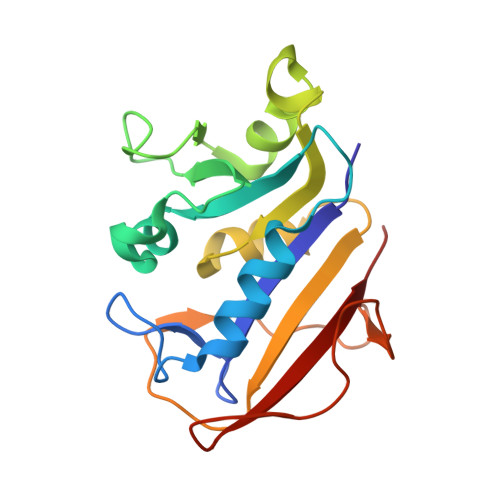Structure determination of tetrahydroquinazoline antifolates in complex with human and Pneumocystis carinii dihydrofolate reductase: correlations between enzyme selectivity and stereochemistry.
Cody, V., Luft, J.R., Pangborn, W., Gangjee, A., Queener, S.F.(2004) Acta Crystallogr D Biol Crystallogr 60: 646-655
- PubMed: 15039552
- DOI: https://doi.org/10.1107/S0907444904002094
- Primary Citation of Related Structures:
1S3U, 1S3V, 1S3W, 1S3Y - PubMed Abstract:
Structural data are reported for the first examples of the tetrahydroquinazoline antifolate (6R,6S)-2,4-diamino-6-(1-indolinomethyl)-5,6,7,8-tetrahydroquinazoline (1) and its trimethoxy analogue (6R,6S)-2,4-diamino-6-(3',4',5'-trimethoxybenzyl)-5,6,7,8-tetrahydroquinazoline (2) as inhibitor complexes with dihydrofolate reductase (DHFR) from human (hDHFR) and Pneumocystis carinii (pcDHFR) sources. The indoline analogue (1) was crystallized as ternary complexes with NADPH and hDHFR (1.9 A resolution) and pcDHFR (2.3 A resolution), while the trimethoxy quinazoline analogue (2) was crystallized as a binary complex with hDHFR in two polymorphic rhombohedral R3 lattices: R3(1) to 1.8 A resolution and R3(2) to 2.0 A resolution. Structural analysis of these potent and selective DHFR-inhibitor complexes revealed preferential binding of the 6S-equatorial isomer in each structure. This configuration is similar to that of the natural tetrahydrofolate substrate; that is, 6S. These data also show that in both the hDHFR and pcDHFR ternary complexes with (1) the indoline ring is partially disordered, with two static conformations that differ between structures. These conformers also differ from that observed for the trimethoxybenzyl ring of tetrahydroquinazoline (2). There is also a correlation between the disorder of the flexible loop 23 and the disorder of the cofactor nicotinamide ribose ring in the pcDHFR-NADPH-(1) ternary complex. Comparison of the Toxoplasma gondii DHFR (tgDHFR) sequence with those of other DHFRs provides insight into the role of sequence and conformation in inhibitor-binding preferences which may aid in the design of novel antifolates with specific DHFR selectivity.
Organizational Affiliation:
Structural Biology Department, Hauptman-Woodward Medical Research Institute, 73 High Street, Buffalo, NY 14203, USA. cody@hwi.buffalo.edu
















